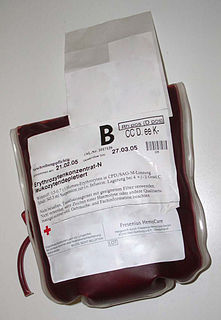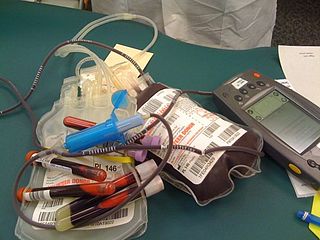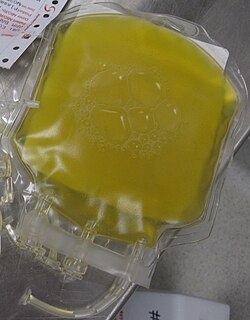Related Research Articles

A blood type is a classification of blood, based on the presence and absence of antibodies and inherited antigenic substances on the surface of red blood cells (RBCs). These antigens may be proteins, carbohydrates, glycoproteins, or glycolipids, depending on the blood group system. Some of these antigens are also present on the surface of other types of cells of various tissues. Several of these red blood cell surface antigens can stem from one allele and collectively form a blood group system.

Blood transfusion is the process of transferring blood products into one's circulation intravenously. Transfusions are used for various medical conditions to replace lost components of the blood. Early transfusions used whole blood, but modern medical practice commonly uses only components of the blood, such as red blood cells, white blood cells, plasma, clotting factors, and platelets.

Platelets, also called thrombocytes, are a component of blood whose function is to react to bleeding from blood vessel injury by clumping, thereby initiating a blood clot. Platelets have no cell nucleus; they are fragments of cytoplasm that are derived from the megakaryocytes of the bone marrow or lung, which then enter the circulation. Circulating inactivated platelets are biconvex discoid (lens-shaped) structures, 2–3 µm in greatest diameter. Activated platelets have cell membrane projections covering their surface. Platelets are found only in mammals, whereas in other vertebrates, thrombocytes circulate as intact mononuclear cells.

Whole blood (WB) is human blood from a standard blood donation. It is used in the treatment of massive bleeding, in exchange transfusion, and when people donate blood to themselves. One unit of whole blood brings up hemoglobin levels by about 10 g/L. Cross matching is typically done before the blood is given. It is given by injection into a vein.

Blood plasma is a light amber liquid component of blood that is freed from blood cells, but holds proteins and other constituents of whole blood in suspension. It makes up about 55% of the body's total blood volume. It is the intravascular part of extracellular fluid (all body fluid outside cells). It is mostly water (up to 95% by volume), and contains important dissolved proteins (6–8%) (e.g., serum albumins, globulins, and fibrinogen), glucose, clotting factors, electrolytes (Na+, Ca2+, Mg2+, HCO3−, Cl−, etc.), hormones, carbon dioxide (plasma being the main medium for excretory product transportation), and oxygen. It plays a vital role in an intravascular osmotic effect that keeps electrolyte concentration balanced and protects the body from infection and other blood disorders.
A blood-borne disease is a disease that can be spread through contamination by blood and other body fluids. Blood can contain pathogens of various types, chief among which are microorganisms, like bacteria and parasites, and non-living infectious agents such as viruses. Three bloodborne pathogens in particular, all viruses, are cited as of primary concern to health workers by the CDC-NIOSH: HIV, hepatitis B (HVB), & hepatitis C (HVC).
A blood bank is a center where blood gathered as a result of blood donation is stored and preserved for later use in blood transfusion. The term "blood bank" typically refers to a division of a hospital where the storage of blood product occurs and where proper testing is performed. However, it sometimes refers to a collection center, and some hospitals also perform collection. Blood banking includes tasks related to blood collection, processing, testing, separation, and storage.

A blood donation occurs when a person voluntarily has blood drawn and used for transfusions and/or made into biopharmaceutical medications by a process called fractionation. Donation may be of whole blood, or of specific components directly (apheresis). Blood banks often participate in the collection process as well as the procedures that follow it.

Apheresis is a medical technology in which the blood of a person is passed through an apparatus that separates out one particular constituent and returns the remainder to the circulation. It is thus an extracorporeal therapy.
Leukoreduction is the removal of white blood cells from the blood or blood components supplied for blood transfusion. After the removal of the leukocytes, the blood product is said to be leukoreduced.

Psoralen is the parent compound in a family of naturally occurring organic compounds known as the linear furanocoumarins. It is structurally related to coumarin by the addition of a fused furan ring, and may be considered as a derivative of umbelliferone. Psoralen occurs naturally in the seeds of Psoralea corylifolia, as well as in the common fig, celery, parsley, West Indian satinwood, and in all citrus fruits. It is widely used in PUVA treatment for psoriasis, eczema, vitiligo, and cutaneous T-cell lymphoma; these applications are typically through the use of medications such as Methoxsalen. Many furanocoumarins are extremely toxic to fish, and some are deposited in streams in Indonesia to catch fish.

Transfusion-related acute lung injury (TRALI) is a serious blood transfusion complication characterized by the acute onset of non-cardiogenic pulmonary edema presenting with hypoxia following transfusion of blood products.

Platelet transfusion, also known as platelet concentrate, is used to prevent or treat bleeding in people with either a low platelet count or poor platelet function. Often this occurs in people receiving cancer chemotherapy. Preventive transfusion is often done in those with platelet levels of less than 10 x 109/L. In those who are bleeding transfusion is usually carried out at less than 50 x 109/L. Blood group matching (ABO, RhD) is typically recommended before platelets are given. Unmatched platelets, however, are often used due to the unavailability of matched platelets. They are given by injection into a vein.
Viral inactivation is to stop the viruses in a given sample from contaminating the desired product either by removing viruses completely or rendering them non-infectious. These techniques are used widely in the food and blood plasma industries, as those products can be harmed by the presence of viral particles. Some of the more common viruses removed by these methods are the HIV-1 and HIV-2 viruses; hepatitis A, B, and C; and parvoviruses. These methods have been adapted to remove prions, which are not related to viruses, from blood products.
Platelet transfusion refractoriness is the repeated failure to achieve the desired level of blood platelets in a patient following a platelet transfusion. The cause of refractoriness may be either immune or non-immune. Among immune-related refractoriness, antibodies against HLA antigens are the primary cause. Non-immune causes include splenomegaly, fever, and sepsis.
Febrile non-hemolytic transfusion reaction (FNHTR) is the most common type of transfusion reaction. It is a benign occurrence with symptoms that include fever but not directly related with hemolysis. It is caused by cytokine release from leukocytes within the donor product as a consequence of white blood cell breakdown .These inflammatory mediators accumulate during the storage of the donated blood, and so the frequency of this reaction increases with the storage length of donated blood. This is in contrast to transfusion-associated acute lung injury, in which the donor plasma has antibodies directed against the recipient HLA antigens, mediating the characteristic lung damage.
Platelet swirling is a noninvasive method for testing the quality of platelet-rich plasma (PRP). Platelet swirling is caused by light diffraction due to the alignment of normal disc-shaped platelets. These discs align light that is diffracted, creating a cloud- or swirl-like appearance.
Plasma frozen within 24 hours after phlebotomy, commonly called FP24, PF‑24, or similar names, is a frozen human blood plasma product used in transfusion medicine. It differs from fresh-frozen plasma (FFP) in that it is frozen within 24 hours of blood collection, whereas FFP is frozen within 8 hours. The phrase "FFP" is sometimes used to refer to any frozen blood plasma product intended for transfusion.
An allergic transfusion reaction is when a blood transfusion results in allergic reaction. It is among the most common transfusion reactions to occur. Reported rates depend on the degree of active surveillance versus passing reporting to the blood bank. Overall, they are estimated to complicate up to 3% of all transfusions. The incidence of allergic transfusion reactions is associated with the amount of plasma in the product. More than 90% of these reactions occur during transfusion.
Cerus Corporation is an American multinational biotechnology company headquartered in Concord, California that develops and provides a treatment system to pathogen-reduce human blood products for the healthcare industry.
References
- 1 2 3 Hardwick CC, Herivel TR, Hernandez SC, Ruane PH, Goodrich RP (2004). "Separation, identification and quantification of riboflavin and its photoproducts in blood products using high-performance liquid chromatography with fluorescence detection: a method to support pathogen reduction technology". Photochem. Photobiol. 80 (3): 609–15. doi:10.1562/0031-8655(2004)080<0609:TNSIAQ>2.0.CO;2. ISSN 0031-8655. PMID 15382964.
- 1 2 Sullivan J, et al. (2008). "Pathogen Inactivation of plasmodium Falciparum in Plasma and Platelet Concentrations with Riboflavin and UV Light". Vox Sanguinis. 95 (Suppl. 1): 278–279. doi:10.1111/j.1423-0410.2008.01056.x. hdl: 10292/2147 .
- ↑ Reddy HL, Dayan AD, Cavagnaro J, Gad S, Li J, Goodrich RP (April 2008). "Toxicity testing of a novel riboflavin-based technology for pathogen reduction and white blood cell inactivation". Transfus Med Rev. 22 (2): 133–53. doi:10.1016/j.tmrv.2007.12.003. PMID 18353253.
- ↑ Larrea L, Calabuig M, Roldán V, Rivera J, Tsai HM, Vicente V, Roig R (December 2009). "The influence of riboflavin photochemistry on plasma coagulation factors". Transfus. Apher. Sci. 41 (3): 199–204. doi:10.1016/j.transci.2009.09.006. PMC 3158998 . PMID 19782644.
- 1 2 3 Ruane PH, Edrich R, Gampp D, Keil SD, Leonard RL, Goodrich RP (June 2004). "Photochemical inactivation of selected viruses and bacteria in platelet concentrates using riboflavin and light". Transfusion. 44 (6): 877–85. doi:10.1111/j.1537-2995.2004.03355.x. PMID 15157255. S2CID 24109912.
- ↑ Goodrich RP, et al. (2006). "Chapter 5:The Antiviral and Antibacterial Properties of Riboflavin and Light: Applications to Blood Safety and Transfusion Medicine". In Edwards, Ana M., Silva, Eduardo (eds.). Flavins: photochemistry and photobiology. Cambridge: RSC Publishing. ISBN 0-85404-331-4.
- 1 2 Fast LD, Dileone G, Marschner S (December 2010). "Inactivation of human white blood cells in platelet products after pathogen reduction technology treatment in comparison to gamma irradiation". Transfusion. 51 (7): 1397–1404. doi:10.1111/j.1537-2995.2010.02984.x. PMID 21155832. S2CID 34154946.
- ↑ Goodrich RP, Custer B, Keil S, Busch M (August 2010). "Defining "adequate" pathogen reduction performance for transfused blood components". Transfusion. 50 (8): 1827–37. doi:10.1111/j.1537-2995.2010.02635.x. PMID 20374558. S2CID 11538115.
- ↑ Cardo LJ, Salata J, Mendez J, Reddy H, Goodrich R (October 2007). "Pathogen inactivation of Trypanosoma cruzi in plasma and platelet concentrates using riboflavin and ultraviolet light". Transfus. Apher. Sci. 37 (2): 131–7. doi:10.1016/j.transci.2007.07.002. PMID 17950672.
- ↑ CaridianBCT. (2010, June 23). CaridianBCT’s Mirasol Pathogen Reduction Technologies System Selected to Increase Safety of Poland’s Blood Supply. [Press Release]. Retrieved from http://www.caridianbct.com/location/north-america/about-caridianbct/press-room/Pages/23JUN,2010-CaridianBCTMirasolPathogenReductionTechnologiesSystemSelectedtoIncreaseSafetyofPoland%E2%80%99sBloodSupply.aspx
- ↑ Business Wire. (2010, July 20). Belgian Red Cross-Flanders Selects CaridianBCT’s Mirasol® Pathogen Reduction Technology System. [Press Release]. Retrieved from http://www.businesswire.com/news/home/20100720007038/en/Belgian-Red-Cross-Flanders-Selects-CaridianBCT%E2%80%99s-Mirasol%C2%AE-Pathogen
- ↑ All Business. (2008, October 6). Warsaw Blood Center Selects CaridianBCT for Mirasol PRT. [Press Release]. Retrieved from http://www.allbusiness.com/medicine-health/public-health-blood-supply-donations/11595632-1.html
- ↑ Healthcare Technology Online. (2008, August 6). CaridianBCT Receives CE Mark for Mirasol Pathogen Reduction Technology System for Plasma. [Press Release]. Retrieved from http://www.healthcaretechnologyonline.com/article.mvc/CaridianBCT-Receives-CE-Mark-For-Mirasol-0001?VNETCOOKIE=NO